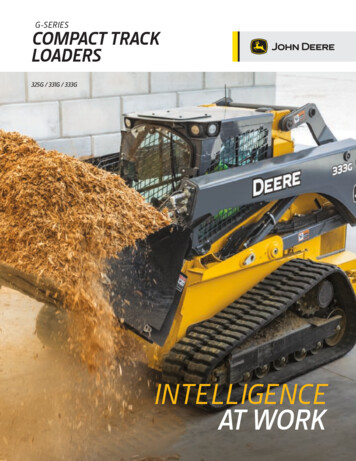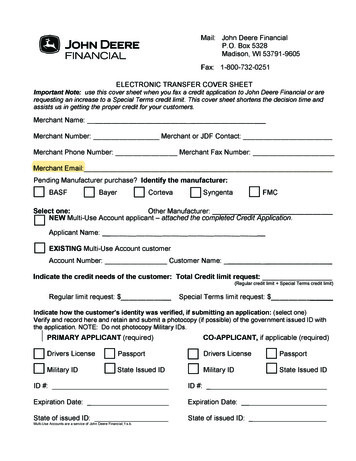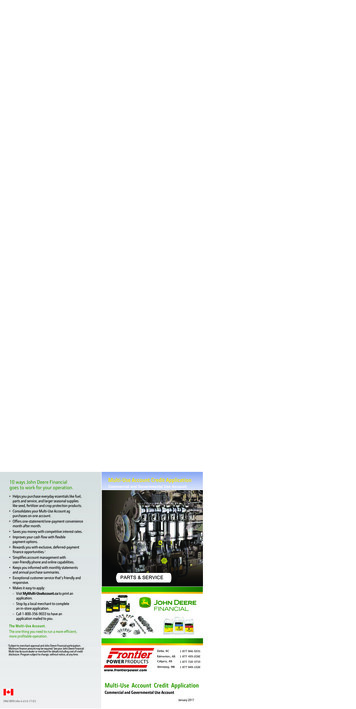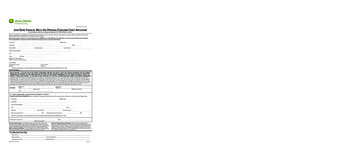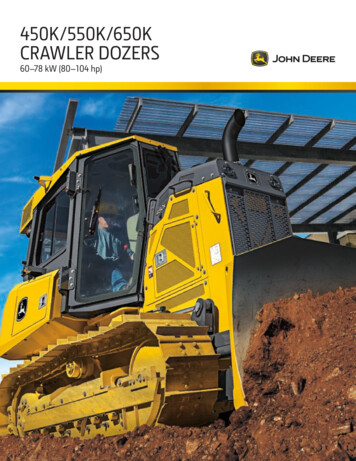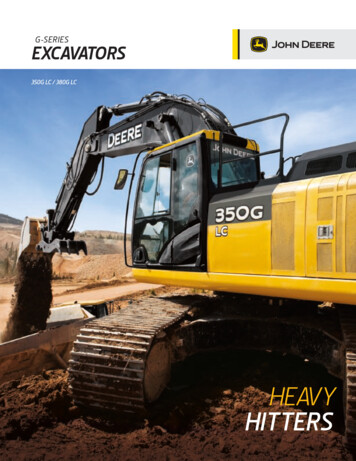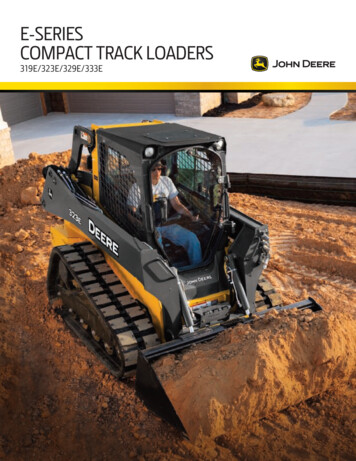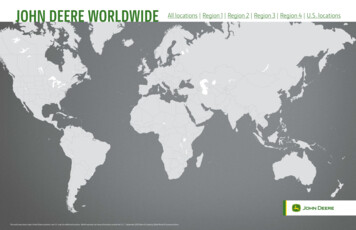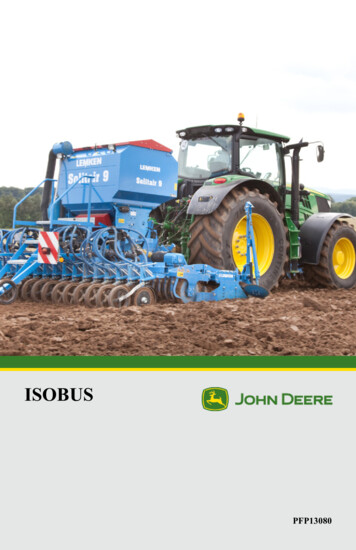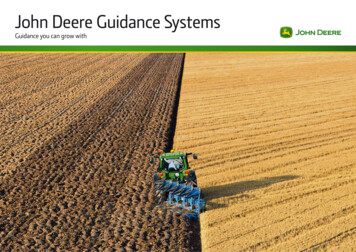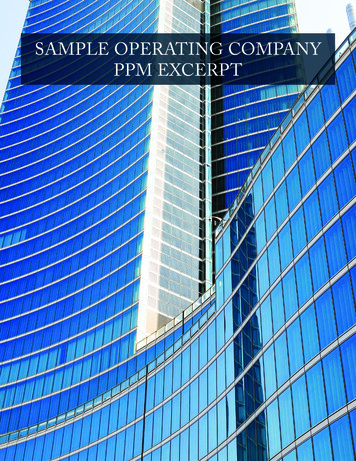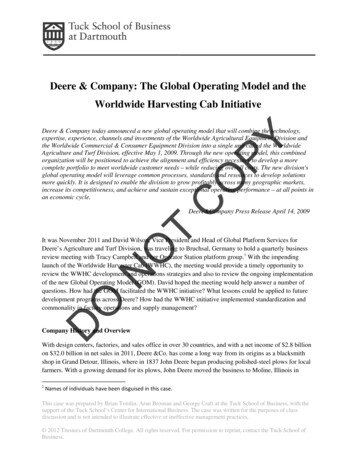
Transcription
Deere & Company: The Global Operating Model and theWorldwide Harvesting Cab InitiativeCOPYDeere & Company today announced a new global operating model that will combine the technology,expertise, experience, channels and investments of the Worldwide Agricultural Equipment Division andthe Worldwide Commercial & Consumer Equipment Division into a single unit called the WorldwideAgriculture and Turf Division, effective May 1, 2009. Through the new operating model, this combinedorganization will be positioned to achieve the alignment and efficiency necessary to develop a morecomplete portfolio to meet worldwide customer needs – while reducing overall costs. The new division'sglobal operating model will leverage common processes, standards and resources to develop solutionsmore quickly. It is designed to enable the division to grow profitably across many geographic markets,increase its competitiveness, and achieve and sustain exceptional operating performance – at all points inan economic cycle.TDeere&Company Press Release April 14, 2009DONOIt was November 2011 and David Wilson, Vice President and Head of Global Platform Services forDeere’s Agriculture and Turf Division, was traveling to Bruchsal, Germany to hold a quarterly businessreview meeting with Tracy Campbell and her Operator Station platform group.1 With the impendinglaunch of the Worldwide Harvester Cab (WWHC), the meeting would provide a timely opportunity toreview the WWHC development and operations strategies and also to review the ongoing implementationof the new Global Operating Model (GOM). David hoped the meeting would help answer a number ofquestions. How had the GOM facilitated the WWHC initiative? What lessons could be applied to futuredevelopment programs across Deere? How had the WWHC initiative implemented standardization andcommonality in factory operations and supply management?Company History and OverviewWith design centers, factories, and sales office in over 30 countries, and with a net income of 2.8 billionon 32.0 billion in net sales in 2011, Deere &Co. has come a long way from its origins as a blacksmithshop in Grand Detour, Illinois, where in 1837 John Deere began producing polished-steel plows for localfarmers. With a growing demand for its plows, John Deere moved the business to Moline, Illinois in1Names of individuals have been disguised in this case.This case was prepared by Brian Tomlin, Aran Brosnan and George Craft at the Tuck School of Business, with thesupport of the Tuck School’s Center for International Business. The case was written for the purposes of classdiscussion and is not intended to illustrate effective or ineffective management practices. 2012 Trustees of Dartmouth College. All rights reserved. For permission to reprint, contact the Tuck School ofBusiness.
Deere & Co.: The Global Operating Model1848. By 1912, Deere had 25 sales offices in the U.S. and Canada and 11 manufacturing facilities. Theemergence of the gasoline engine tractor in 1915 threatened to disrupt the agricultural equipmentindustry, and Deere’s 1918 acquisition of a gasoline engine tractor producer was a pivotal moment in thecompany’s history, with the tractor being one of its dominant products over the following century.Deere’s product portfolio grew in the 1940s and 1950s with its entry into the construction-equipmentbusiness. However, Deere did not expand its manufacturing footprint outside the U.S. and Canada until1956, when it built an assembly factory in Mexico and acquired a majority interest in a Germanagricultural equipment manufacturer.OPYThe following decade saw Deere’s footprint expand in Europe, South America and Africa. New productintroductions in 1960 paved the way for Deere to become the world’s largest manufacturer of agriculturaland industrial tractors and related equipment. The 1960’s also saw the company’s entry into consumermarkets, making and selling garden tractors. In the following decades Deere’s business grew both in scaleand complexity, with the company acquiring a forestry-equipment producer in 2000 and building oracquiring a variety of production facilities in India (1998), Brazil (2004), Russia (2005) and China (2007).Deere’s global footprint was not limited to production facilities; it also had technology centers in a rangeof countries.CBy 2008, Deere was organized into four divisions: Agricultural Equipment, Commercial & ConsumerEquipment, Construction & Forestry Equipment, and Financial Services. As described in the company’s2008 Annual Report:NOTThe company’s Equipment Operations generate revenues and cash primarily from the sale ofequipment to John Deere dealers and distributors. The Equipment Operations manufacture anddistribute a full line of agricultural equipment; a variety of commercial, consumer andlandscapes equipment and products; and a broad range of equipment for construction andforestry. The company’s Financial Services primarily provide credit services, which mainlyfinance sales and leases of equipment by John Deere dealers and trade receivables purchasedfrom the Equipment Operations.OThe Agriculture division generated 64% of Deere’s 25.8 billion in net sales in 2008, with theCommercial & Consumer division and the Construction & Forestry division accounting for 17% and 19%respectively.DTo be successful in their markets, Deere products must be technologically advanced and reliable andcome with effective after-sales field-support. Agricultural equipment, such as harvesters for example, arehighly sophisticated machines, integrating complex hardware, electronics and software. In fact, “today’slarge John Deere tractors have more lines of software code than early space shuttles [and Deere’s] GPStechnology can guide a tractor and implement in the field with near-perfect precision. This means lessoverlap in tillage and chemical application, saving time and money and minimizing environmentalimpacts.”2 Exhibit 1 shows a scene from the Virtual Reality Lab at Deere’s Waterloo Product EngineeringCenter. Examples of Deere products are shown in Exhibit 2(a)-(c).2David Everitt, President, Agriculture and Turf Division – North America, Asia, Australia, and Sub‐Saharan andSouth Africa, and Global Tractor and Turf Products. Quote from speech to Ag Investment Summit, 10/20/11.The Tuck School of Business at Dartmouth2
Deere & Co.: The Global Operating ModelThe Agriculture and Turf Division and the Global Operating ModelPYDeere’s relentless expansion in the second half of the twentieth century created a global footprint ofdesign centers and factories that developed and manufactured products for different regions of the world.Products and regions tended to have a large degree of autonomy in designing products, selectingsuppliers, running factories and managing distribution channels. Decentralization was a keyorganizational philosophy. While this organizational model had served Deere well for a number ofdecades, the increased competition and globalization in the 2000’s caused senior management to askwhether the existing model was enabling Deere to fully leverage its expertise, technologies, talent, saleschannels and global footprint. There was a growing sense that the business was not as fast as it could be,not as cost competitive as it needed to be, and that it was harder to do business with it than it should be.OIn 2008, Deere began to develop a new organization structure and operating model. The AgricultureEquipment and Commercial & Consumer Equipment divisions were combined to create the WorldwideAgriculture and Turf Division in 2009. At the same time, Deere began the implementation of a newGlobal Operating Model. The objective of this transformation was to significantly improve Deere’s abilityto understand and act on global market opportunities, to leverage global scale, to share resources, and tooptimize global product line results.N T Customer driven: All efforts are aligned to understand, design and deliver a differentiated JohnDeere experience to targeted customers.Differentiating speed: Reduce cycle times to differentiate the customer experience and achievebusiness results.Standard Processes: Utilize globally standard processes, terminology and metrics.Partner Collaboration: Integrate partners to generate shared value and drive business results.Talent Development: Attract, rapidly develop and retain global talent (at all levels).O CThe Global Operating Model (GOM) was founded on five guiding principles.OTo achieve the objective of better leveraging its global resources, the GOM organized the newly formedAg&Turf division into Customer Focus Regions, Product Platforms, Platform Services, Customer FocusServices, Strategic Marketing, Core Enablers, Solutions, and Division Level Functions. See Exhibit 3 foran illustration of the new organization structure.DCustomer Focus RegionsRather than grouping countries solely by geographic proximity, Deere analyzed customer needs andmarket characteristics to identify collections of countries that exhibited sufficient similarities that Deerecould leverage to its own and to its customers advantage. For example, Australia was grouped withCanada and the United States in one region. The four regions are shown in Exhibit 4. Each of the fourregions would be responsible for sales, tactical marketing and customer support and each hadaccountability for its marketing strategy, profitability, and market share growth.External PlatformsDeere’s extensive product line contained families of products that performed a similar set of functions;for example, although different types of crops require different harvesting equipment, many of theThe Tuck School of Business at Dartmouth3
Deere & Co.: The Global Operating Modelunderlying customer requirements are similar from one crop to another. So as to leverage these functionalsimilarities across products, Deere created five External Platforms: Tractors, Crop Harvesting, Turf andUtility, Hay and Forage and Crop Care. Each external platform was to be managed as a profit center toglobally optimize its product and manufacturing portfolio.3 External platforms would have globalaccountability for portfolio decisions, portfolio sourcing and product delivery. They would be responsiblefor product planning, product development, product line management and production planning.Platform ServicesCOPYThe Platform Services organization was designed to be a shared service producing parts for anddelivering services to the External Platforms. Global Platform Services comprised three InternalPlatforms: Operator Station; Hydraulic Cylinders and Components & Fabrication. The intent of theInternal Platforms was to efficiently leverage common components and systems across External Platformsto enable effective technology development and to optimize asset usage. In addition to the InternalPlatforms, the Platform Services organization comprised Product Engineering Services, Manufacturing &Manufacturing Engineering Services, Process Management and Business Process Transformation.Managed as a cost center, the vision was for Platform Services to improve Deere’s overallcompetitiveness by driving performance improvement through leverage and synergy across commonprocesses, capabilities, and components. The Platform Services organization chart is shown in Exhibit 5.Customer Focus ServicesTThe Customer Focus Service organization would be responsible for providing the four regions withsupport and shared services in the areas of customer and product support and order fulfillment.OStrategic MarketingCore EnablersNThe Strategic Marketing organization would be responsible for gathering and prioritizing customer needsglobally and to help inform the regions and external platforms on how to sustainably grow market share.OThe Core enablers would be responsible for the worldwide management of standard processes, systemsand shared services in the areas of Finance, Human Resources and Information Technology.DDivision Level FunctionsCertain functions, such as Quality and Supply Management, would be managed as division level functionsupporting the external platforms and customer-focus regions.The Global Operating Model represented a major transformation of Deere’s structure, and its impactwould be felt across all facets of the organization. Taking Platform Services as an example, the GOMwould fundamentally alter a number of key dimensions. For example, prior to GOM, core technologies in3Whereas Customer Focus Regions were concerned with profitability by geography, External Platforms wereconcerned with profitability by product.The Tuck School of Business at Dartmouth4
Deere & Co.: The Global Operating Modelcomponents, cylinders and operator stations were driven by individual product line requirements,resulting in a technology portfolio that had potential for significant overlap and redundancies acrossproduct lines. Perhaps not surprisingly, opportunities to share parts across products were not alwaysexploited. Post GOM, leveraging part commonality (while still being responsive to External Platformneeds) would receive a higher priority when creating technology roadmaps.PYThe organization and vision for manufacturing engineering was also transformed by the GOM. Instead ofindividual products and factories owning the deployment and development of manufacturing services andcompetencies, the GOM created a Manufacturing/Manufacturing Engineering (MFG/ME) organizationwithin Platform Services. While certain MFG/ME resources would still be located at factories, theMFG/ME Internal Platform would enable Deere to align these resources with their respective ExternalPlatforms and would also enable the deployment of common manufacturing engineering processes, toolsand standards on a division-wide basis.ODecision RightsTCAs is the case for all globally complex business, crucial processes (such as translating customerrequirements into a product specification) have the potential to impact a range of internal constituen
organizational philosophy. While this organizational model had served Deere well for a number of decades, the increased competition and globalization in the 2000’s caused senior management to ask whether the existing model was enabling Deere to fully leverage its expertise, technologies, talent, sales channels and global footprint. There was a growing sense that the business was not as fast .

